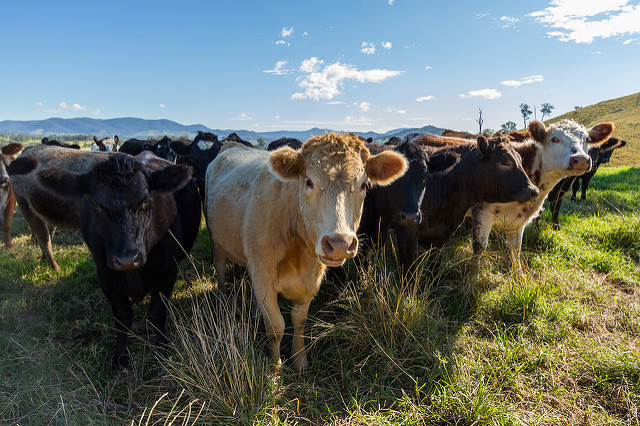I was a beef rancher for 20 years.
I’ve raised cow and calf pairs (mama cows and baby calves), I’ve raised yearlings, and I’ve raised beef steers (steers are castrated bulls). Let’s face it, there is nothing romantic about the beef business—or the dairy business for that matter.
Vegans are still the vast minority—people love a good steak and their creamy desserts. I doubt that most people understand the arguments against the cattle industry in general, or why it is not only unhealthy for the environment, but for us as well. If anyone reading this article has ever worked on a beef cattle ranch, feed lot, dairy farm or veal farm—you don’t need to read any further. You know what I am going to disclose, and it isn’t pretty.
First of all, let me tell you that there is a reason that cattle are at the bottom of the food chain. They are lazy, they are stubborn, and they will hurt you in a heartbeat. It’s true that it is possible to domestic cattle to be pets, but that is not a sign of their intelligence. That is a sign of training and laziness. That does not, however, give us the right to treat them the way that the beef and dairy industries treat them, which is outrageous.
Beef is the food source of choice for most of the world, and dairy (milk, cheese, ice cream) is right up there with beef. Waygu beef is grown principally in Japan, but has been introduced to the United States. It costs hundreds of dollars a pound on the plate as a steak, perhaps a little less when it is mixed with pork fat and sold as hamburger. Gross.
Let me explain something about the way beef is graded. There is prime, choice, select—and everything else. The difference between these grades is principally the amount of intramuscular fat, known as “marbling.” It is the spider web of white fat lines criss-crossing your steak when it is raw and makes it so tender and juicy when it is cooked. The further down the scale you go, the less fat it contains. That is why grass fed beef is rarely graded prime, as there is little fat in the meat. Grass fed beef is tough, chewy and either gamey or tasteless, depending on what camp you’re in. That is the trade-off you make with beef—either it is prime and fatty or lean and awful (my shoe would taste and chew better.)
The rub is that to get all of that fat, you have to feed the beef cows with steroids, corn and high calorie diets. Fat is the place where all beings store toxins. The toxins of steroids, corn and high calorie foods increases the fat in beef, so while it may taste better, it is much more toxic to consume.
Commercial beef is the worst. It is filled with steroids, antibiotics and vaccines that make the beef more tender and marketable (expensive). It is possible to get prime-grade organic beef (I produced it), but the cost is prohibitive if you’re intending on making a living at it. No one wants to pay a fair price to the rancher to produce that quality of healthily raised beef. So the rancher sells their cows to a feed lot, where it is fed silage (probably from a brewery—it’s grain that has been boiled, and what remains is nutrient void-empty calories ) and other high carbohydrate calorie feeds to make it gain fat.
So when you are in a restaurant that is selling a prime-grade, corn-fed beef, you are screwing yourself over, big time.
Trust me, I raised that stuff. It is going to wreak havoc with your colon and digestive tract. Please eat it with a bottle of ex-lax—the longer it stays in your digestive tract, the more chance you will have to get colon cancer.
That brings us to dairy cattle. As bad as the beef cattle industry is, I feel worse for the dairy cattle. At least the beef industry recognizes the appeal of open range beef, with the illusion of cowboys and cattle drives. That doesn’t exist anymore (my son is a cattle rancher, and he doesn’t own a horse, he uses a four wheeler). Dairy cattle don’t even have that going for them. I have been to dairy farms that have thousands of dairy cows. It is disgusting. There aren’t pastures for commercial dairy cows. There are feed lots that are principally mud and shit. The biggest problem is mastitis, an infection that causes pus in the milk that they produce for our consumption. Bessie went home a long time ago.
Commercial milk is produced by cattle that have no chance for any kind of contented life. They stand so long that they lose their hooves. Milk is produced by cows that are or were pregnant. Once a cow is pregnant, it starts to produce milk. If the cow is continued to be milked, it will continue to produce milk, like a wet nurse. At some point they will have to be impregnated again, to keep the cycle going. So what do they do with the calves?
Dairy farmers want female cows, not bulls. Bulls don’t milk, unless you are really brave and stupid. So where does veal come from? When dairy cows deliver bulls, which are useless to a dairy farmer, they are put in cages for two months while they are fattened up to be slaughtered. The cages look like plastic domes and there are thousands in a commercial dairy. They never get out of these plastic cages. It is heart breaking so see. So enjoy your veal (as best you can) or now consider yourself educated and stop it.
Nutritionally, there is no reason to drink milk, or eat cheese or ice cream. A lot of disease, obesity and digestive diseases are linked to dairy products. At least meat has enzymes that may be useful. It is your choice to support the exploitation of a four legged animal by drinking milk, or eating cheese and ice cream.
The spiritual implications are enormous. After all, how good is karmic flavored ice cream anyway? There was a time when everything I just stated from my direct experience was not the case. Bessie lived out back. She was happy and not over-bred, and Bobby—well, he was probably blessed for the life he gave, before he showed up on the dinner table for family supper. You knew what went into either cow or steer, and there was no hurry to harvest either one. You didn’t have a profit and loss margin you had to make every month—but those days are long gone.
I am sure all of my ranching buddies will cry “foul” but the truth is the truth. The poisons that we put into cattle are going directly into you. So eat organically and grass fed (not the same thing) to at least get the safest beef possible. It may not taste as good, but you won’t get colon cancer (maybe). The only safe bet on milk is to find a local farm that will sell you raw milk. See what they are feeding their dairy cows. Take control of your health.
Take it from me, there are too many good alternatives to beef to keep eating it. Move’m out, Rawhide!
.
Author: James Robinson
Editor: Yoli Ramazzina
Photo: Flickr/Marc Dalmulder









Read 9 comments and reply